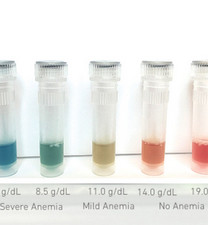No. 22: An at-home test for anemia

Your body’s red blood cells keep you going – they carry oxygen and remove carbon dioxide. But imagine they’re disappearing. Your body is producing less of them, or something unknown is destroying them. When this happens, you likely have anemia.
Anemia is both a condition and a constant threat. If it’s not monitored, it can lead to heart failure or organ damage. To keep a tally of their red blood cells, the 2 billion people worldwide who have anemia typically must visit a clinic or doctor’s office to be tested. While a few at-home tests are available, they’re either expensive, hard to use or limited to certain types of anemia.
But an enterprising student enrolled in Emory and Georgia Tech’s Coulter Department of Biomedical Engineering found a way to surmount those obstacles.
Working with Dr. Wilbur Lam, an assistant professor in the department, Erika Tyburski developed a simple, single-use test that provides an accurate reading of anemia. The test blends a person’s blood with a chemical reagent, triggering a reaction that reveals the level of hemoglobin, the protein responsible for carrying oxygen in the body.
Their process is performed through a disposable home kit that costs a fraction of other point-of-care tests. Its simplicity is remarkable: prick the finger and touch the blood drop with a tiny tube. The tube, attached to a cap, auto-fills with the blood; the cap is screwed back onto a vial containing fluid (the reagent). Within a minute, the fluid changes color, the shade of which determines anemia.
The development of the test, called AnemoCheckTM, brought the 2014 launch of a company, Sanguina, which received early investment from GRA Ventures. Following a final review from the U.S. Food and Drug Administration, the test is expected to be available in stores early in 2017.
“AnemoCheck doesn’t require additional equipment or electrical power,” says Dr. Lam, who is also a pediatric hematologist at Emory and Children’s Healthcare of Atlanta. “And while it’s ideal for patients with chronic anemia, it will really have a significant impact in poorer countries where severe anemia is highly prevalent, and where current anemia tests are cost-prohibitive.”
